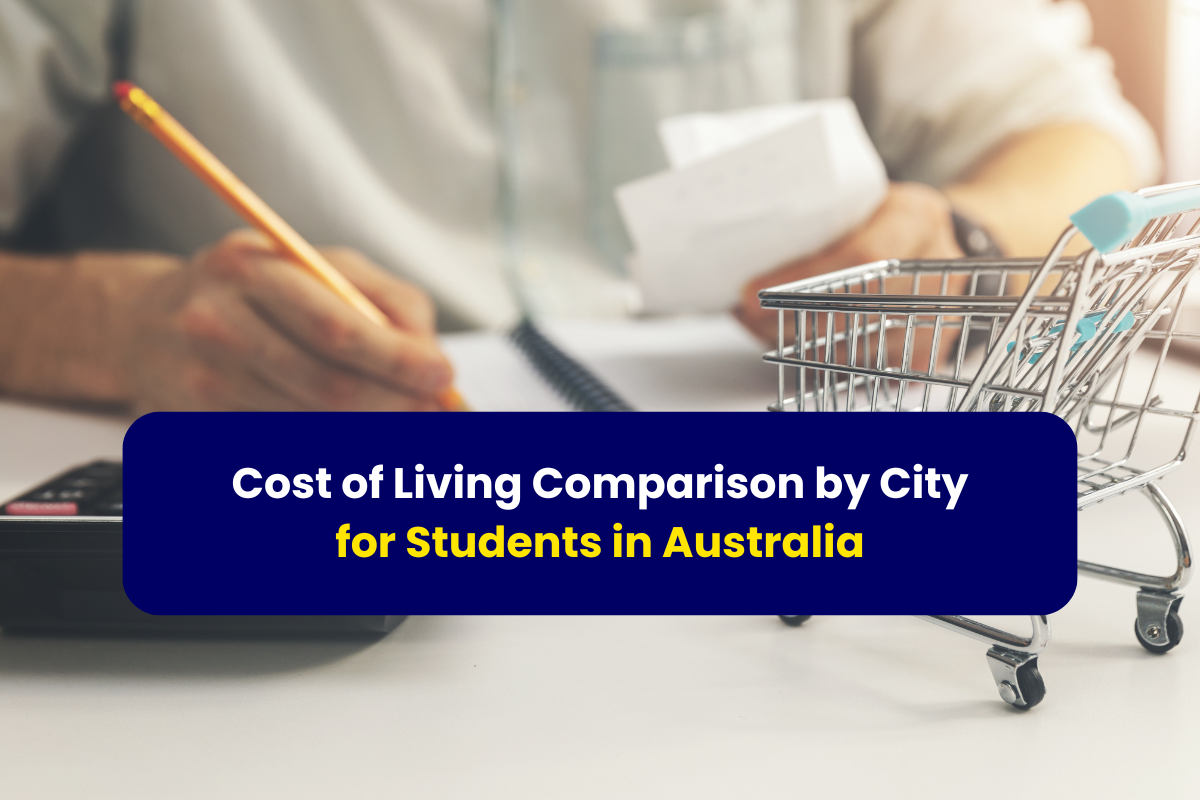Cost of Living Comparison by City for Students in Australia

How big of a role should your cost of living comparison by city play in choosing the right location to study abroad? Australia is home to some of the most student-friendly cities in the world. Every year, more than 750,000 students from around the globe choose Australia as their study abroad destination. Aside from some of the best universities in the world, a big factor in attracting these students is these student cities.
Student cities in Australia range from some of the most affordable to some of the most expensive. However, these expensive cities also tend to be where diversity, employer activity, and convenience of living are highest. Every city has its ups and downs – and if cost is a significant factor in choosing the right one for you, this blog is a great place to start figuring your options out.
The Top Student Cities in Australia
Home to some of the best universities in the world, Australian cities have large communities of international students. QS Top Universities ranks the best student cities in Australia as:
| City | QS Best Student Cities 2025 Ranking |
| Melbourne | #5 |
| Sydney | #6 |
| Brisbane | #25 |
| Adelaide | #28 |
| Canberra | =29 |
| Perth | #35 |
| Gold Coast | #93 |
What Makes a Great Student City?
Two Australian cities make the top ten of the world’s best student cities, with Melbourne and Sydney almost back to back at #5 and #6 respectively. Because QS Top Universities employs a thorough, scientific methodology to calculate these rankings, these numbers reflect how great these cities are as student destinations. The metrics that go into determining these rankings include:
● University rankings: The best universities in or around that city
● Student mix: Mix of communities of students from different cultures and countries
● Desirability: Desirability of life in the city using metrics like safety, pollution levels etc.
● Employer activity: Graduate employability and degrees of youth employment in the city
● Affordability: Average tuition and costs of living in the city
● Student view: How students feel about aspects of the city such as friendliness, diversity, sustainability, and staying back in the city after graduation
It is worth mentioning when doing your cost of living comparison by city that you should not write off all the universities in less affordable cities because of ranking alone. Sydney and Melbourne are home to some of the top universities in Australia, shooting them up the ranks of best student cities but also bumping the score down for affordability. Tuition fees at large, prestigious universities in expensive cities tend to be higher.
However, there are plenty of excellent and more affordable alternatives for students in these cities too. Affordability itself is a very subjective concept and its definition can vary from person to person. Some students may be willing to foot a bigger bill for the payoff of studying and living in Australia’s best student cities.
To help you make the best choice available to you, we break down how costs may look for you in Australia’s student cities below:
The Cost of Living in Australian Cities
Aside from the cost of education, you need to consider the cost of living when deciding which city to live in. According to Australian visa guidelines, the minimum funds you should hold in savings for living costs as an international student is AUD 24,505 per year. However, the absolute cost of living is a complex calculation with no straightforward answer.
There are many factors to consider to understand your cost of living comparison by city, which can look different from someone else’s. To get a proper assessment, you need to consider each factor separately and compare them among the cities you want to choose from. Some of the most important considerations when calculating the cost of living include rent, food and necessities, transport, and entertainment.
Rent
Rent is likely going to be the most substantial component of your budget when calculating your living expenses. As an international student, you will be spending most of your monthly budget paying rent for the room or space that you decide to live in. Many Australian universities offer on-campus housing that international students often prefer because of the convenience. Others move off-campus thanks to the availability of lower rent farther away from campus. Using official estimations, you can consider the following weekly rent expenses in Australian student cities:
| City | Weekly estimated rent (AUD) |
| Gold Coast | $232 - $452 |
| Adelaide | $227 - $471 |
| Perth | $214 - $532 |
| Canberra | $307 - $502 |
| Brisbane | $242 - $492 |
Sydney and Melbourne are the costliest cities for international students in Australia when it comes to rent, with some housing options exceeding AUD 800 per week. Our cost estimates use the Australian government’s official cost of living calculator, which you can also use as a great resource for your cost of living comparison by city!
Another important aspect to consider when calculating rent is where in the city you will live. In general, residing in the city center tends to be more expensive than living in the suburbs. This choice will depend on the location of your university, as you may want to live as close as possible to campus.
The third and final consideration for rent is your type of accommodation. Generally, the type of accommodation can determine how expensive or affordable rent will be:
| Type of Accommodation | Cost |
| Shared housing | $ |
| Homestay | $$ |
| Managed Apartment | $$$ |
| One-Bedroom Unit | $$$$ |
Food and Necessities
Food and necessities are the second-largest expense group that you will need to budget for while studying abroad. While living costs in your city of choice impact the prices of groceries, part of your expenses also depends on your lifestyle, habits, and choices. Habits like eating at home and making your own food can go a long way in decreasing your food budget.
To break it down a little more, food costs can depend partly on how often you are eating out and what you are eating. The quick and easy equation is that eating out often will be more expensive than prepping your meals at home. What kinds of meals you are ordering in can also impact costs, whether this is fast food or diner fare or expensive restaurant meals. Again, this will vary from person to person, and inputting details of your lifestyle into a cost of living calculator would better help you understand your unique expenses.
Your average cost of living comparison by city for meals can look like this:
| Days eating outside | Average monthly expenses (AUD) |
| 0 days per week | $560 |
| 2 days per week | $848 |
| 3 days per week | $992 |
| 5 days per week | $1280 |
| 7 days per week | $1568 |
Aside from eating out, another aspect of your expenses will be necessities like mobile plans, haircuts, and personal hygiene products. You may also want to put aside a part of your budget for a gym membership or to go shopping. Average costs for some of these expenses can be as follows:
| Services or Products | Weekly cost ranges (AUD) |
| Gym | $10-$15 |
| Haircuts | $10-$15 per haircut |
| Cosmetics | $5-$8 |
| Mobile Plans | $15-$20 |
| Clothing | $30-$50 |
Transport
Another thing you will need to include in your budget is the transport costs of your commute and general mobility around the city. You will be traveling to and from your university every day if you are living off-campus. You would also be heading out to grab groceries and meals, shop, hang out with friends, and do other errands and social activities. Your transport costs will depend on the mode of transport you choose to take as well as how often you take it. Walking and cycling can definitely save you the most money. However, each of Australia’s cities offers its own public transport system, and with student concessions like discounts and passes, getting around town can be quite cheap!
The cost of public transport in Australian cities can look as follows:
| City | Weekly estimated costs (AUD) |
| Gold Coast | $31-$50 |
| Adelaide | $20-$29 |
| Perth | $35-$44 |
| Canberra | $33-$43 |
| Brisbane | $42-$55 |
| Melbourne | $37-$50 |
| Sydney | $43-$55 |
Entertainment & Social Activities
The final thing to consider in your cost of living comparison by city is the cost of entertainment and social activities. After all, although you are an international student and academics are the key part of your focus, you are in an exciting country with tons to explore. It’s not an opportunity to miss and to experience your student city to the fullest, you will need to set aside some of your budget.
If you’re an average student in Australia, you might be going out on the weekends and attending occasional sports and music events. Including an average amount of entertainment activities, you can get an assessment of the expenses in each city.
| City | Weekly estimated cost for entertainment (AUD) |
| Gold Coast | $65 |
| Adelaide | $74 |
| Perth | $145 |
| Canberra | $178 |
| Brisbane | $83 |
| Melbourne | $97 |
| Sydney | $106 |
Most Affordable Cities in Australia
Melbourne and Sydney are, according to QS Best Student Cities 2025, the most expensive cities for students in Australia. Sydney even ranks as the 10th most expensive city in the world. The capital, Canberra, also leans toward the more expensive side. The cost of living in these big cities is significantly higher than the smaller ones. Nonetheless, these cities also see some of the biggest concentrations of international students thanks to the presence of world-class universities, top employers, modern facilities, and multicultural communities.
Student cities like Perth and the Gold Coast, on the other hand, rank as the most affordable overall in Australia. The tradeoff may be in factors like a faster-paced lifestyle, but these cities are also home to world-ranking universities.
Below are the affordability ratings of Australia’s student cities, from least to most expensive, according to QS Best Student Cities:
| City | Affordability Rating |
| Gold Coast | 32.5 |
| Perth | 30.2 |
| Adelaide | 28.1 |
| Canberra | 26.1 |
| Brisbane | 23.8 |
| Melbourne | 22.7 |
| Sydney | 18.7 |
Rounding Up
Considering the student city while researching your list of university courses to study abroad makes an important difference to your costs. Your cost of living comparison by city can help guide you in pinpointing where you want to study and the universities and opportunities available there. Our cost breakdown looks into averages and estimates, but remember that living expenses can vary quite broadly within and between cities, and of course, from person to person.



